#to the lighthouse and a room of ones own by. virginia woolf
Text
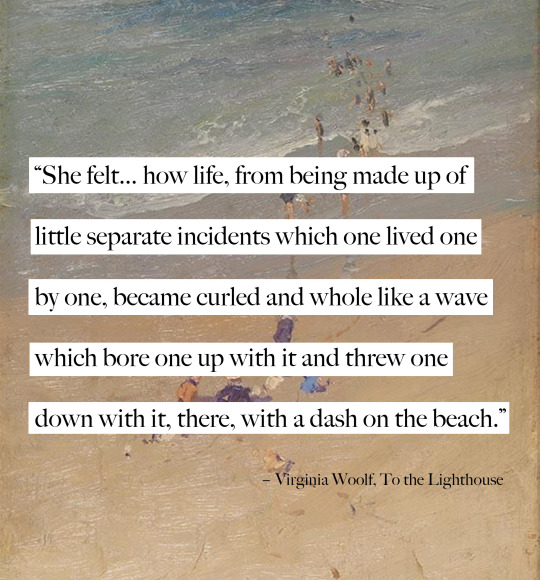
“She felt... how life, from being made up of little separate incidents which one lived one by one, became curled and whole like a wave which bore one up with it and threw one down with it, there, with a dash on the beach.” - Virginia Woolf, To the Lighthouse
#virginia woolf#to the lighthouse#orlando#the waves#a room of one's own#sylvia plath#the bell jar#classical literature#albert camus#classics#poetry#classical poetry#classical quotes#existentialism#light academia#writers on tumblr#writers of tumblr#writers#writers and poets#spilled writing#spilled ink#spilled poetry#poetic#poets on tumblr#poems#biblophile#female writers#jane austen#emily bronte#agatha christie
48 notes
·
View notes
Text
virginia woolf

virgina woolf was born this day (january 25) in 1882
virginia woolf was a modernist author, known for her innovative writing style and popular works such as to the lighthouse and a room of one's own
#birthday#happy birthday#celebs#virginia woolf#authors#literature#modernism#to the lighthouse#mrs dalloway#books and reading#books & libraries#books#bookblr#a room of one's own#on this day#on this date#this day in history
4 notes
·
View notes
Text

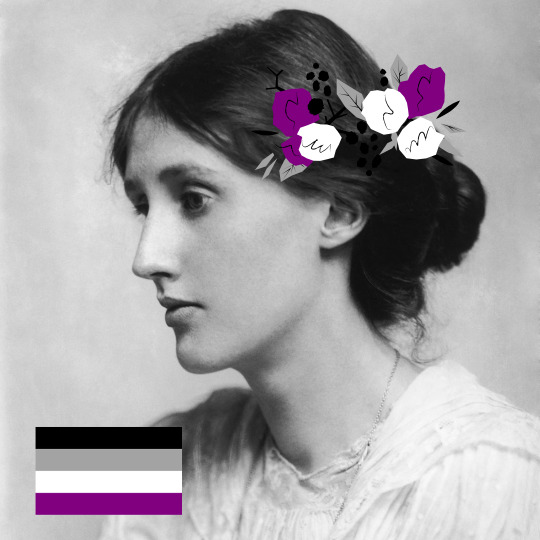
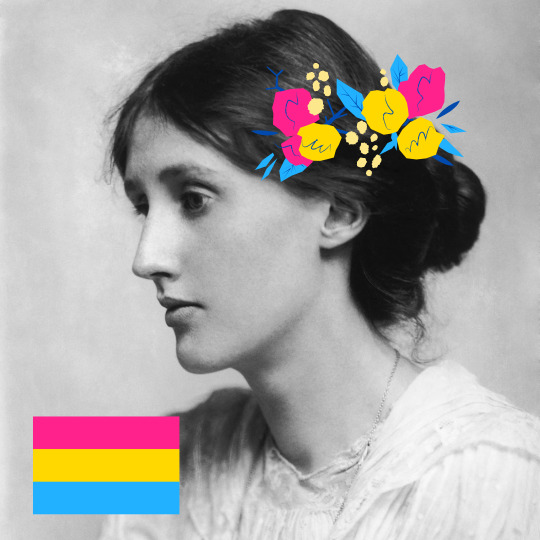


Virginia Woolf (1882-1941)
British modernist author of novels and essays with a great feminist value
notable works: "Mrs. Dalloway", "To The Lighthouse", "Orlando", "The Waves", "A Room of One's Own"
she struggled with bipolar disorder throughout her life, being constantly lifted up by her husband, Leonard Woolf, whom she loved dearly
together, the Woolfs founded Hogarth Press, which published Virginia's books
she had a relationship with Vita Sackville-West, a fellow writer, who inspired the character of Orlando, the protagonist who switches genders in her eponymous novel
she committed suicide in 1941, at age 59, leaving behind a body of work translated in over 50 languages
-
"For it would seem - her case proved it - that we write, not with the fingers, but with the whole person. The nerve which controls the pen winds itself about every fibre of our being, threads the heart, pierces the liver."
("Orlando: A Biography", Virginia Woolf, 1928)
"She thought there were no Gods; no one was to blame; and so she evolved this atheist's religion of doing good for the sake of goodness."
("Mrs. Dalloway", Virginia Woolf, 1925)
-
#virginia woolf#woolf#to the lighthouse#mrs dalloway#orlando#a room of one's own#the waves#writers#modernist writers#literature#classic literature#classic writers#queer authors#lgbtq#bisexual#asexual#queer#pride#profile pics#quotes#classic quotes#prose#classics#writing#books
10 notes
·
View notes
Text

Nothing really happens in this novel. Apart from one death that is central to the narrative and moves not things, but the state of things along, To the Lighthouse is mainly a patch of stream of consciousness from different points of view. And even this “big event” of this character’s death is merely mentioned, out of nowhere, with no further explanation. Woolf doesn’t care about what happens, only about how something feels. She spends these 200 pages painting a portrait of a bucolic bourgeois scene on the Isle of Skye in the 1910s, with a very faint hue of the First World War happening in the background — “contemplation was unendurable; the mirror was broken. (...) The war, people said, had revived their interest in poetry”.
Woolf paints a picture, just like her Lily Briscoe does for 10 years. This character’s artistic musings seem to embody Woolf’s own: the act of composition, be it of Briscoe’s painting, or of the novel itself, is more important than the final product. The mental process prevails over action: “Some notion was in both of them about the ineffectiveness of action, the supremacy of thought”, she writes.
“Where to begin?--that was the question at what point to make the first mark? One line placed on the canvas committed her to innumerable risks, to frequent and irrevocable decisions. All that in idea seemed simple became in practice immediately complex; (...) Still the risk must be run; the mark made.”
This was my first Woolf novel; so far, I had only read A Room of One’s Own (1929) and her short story “The Lady in the Looking Glass: A Reflection” (1929). I found that her fictional writing is much more complex than her essayistic one, requiring at first a bit of an effort to get acclimated to her abundant use of semicolons and of interior monologue. However, thematically, I was able to find here and there bits of each of these works I previously knew:
In A Room of One’s Own, Woolf critics academia, pointing out its underlying misogyny and invents an abstract sister for Shakespeare, demonstrating how, if the latter had been a woman, she would’ve never had the success that he had as a man. In this novel, these critiques are subtly hinted at here and there: a character states to Lily that “women can’t paint, women can’t write”. Another character asks, “If Shakespeare had never existed (...) would the world have differed much from what it is today? Does the progress of civilization depend upon great men?” and affirms that “the very stone one kicks with one’s boot will outlast Shakespeare.”
The novel also hints at her short story “The Lady in the Looking Glass: A Reflection”, which describes an empty room reflected in a mirror. Both works express a kind of spatial melancholy, painting a scene which brings subjectivity to mundane objects: “how once the looking-glass had held a face; had held a world hollowed out in which a figure turned” (from To the Lighthouse). In both, houses and spaces become characters. The novel is divided into three parts: “The Window”, “Time Passes”, “The Lighthouse”. In the second part, the house itself becomes the abandoned protagonist, as we follow it through the years, empty.
But the passages that stuck with me the most are from the first part, relating to the character of Mrs Ramsay, a mother of eight: “So boasting of her capacity to surround and protect, there was scarcely a shell of herself left for her to know herself by; all was so lavished and spent”. While Lily Briscoe represents Woolf’s artistic vision and a feminist denial of female stereotypes, and while Mrs Ramsay stands on the complete opposite side of this, she does however represent in her resignation the female condition in its most subtle anguishes: “They came to her, naturally, since she was a woman, all day long with this and that; one wanting this, another that; the children were growing up; she often felt she was nothing but a sponge sopped full of human emotions”; “Again she felt (...) the sterility of men, for if she did not do it nobody would do it”. What I also really appreciated was the age of these female characters, since literary representation (specially up until Modernism, one could argue), tends to be drawn to younger women and girls. Woolf, on the other hand, gives voice to the atemporal feelings of mature womanhood: Mrs Ramsay’s age isn’t specified, but we can infer she is a middle-aged woman, while Lily starts the novel at 34 and, by the end of her artistic meditations, she is 44 years old.
Throughout the narrative pervades a consistent inherent longing for things one cannot have: a moment, a father’s approval, a presence, the lighthouse. Considered to be her most autobiographical novel, To the Lighthouse is inspired by Woolf’s family and their holiday house, which explains the pervasive atmosphere of nostalgia for something the reader doesn’t quite understand. Written like an impressionist painting, it feels like a fragment of memory. At the end, the characters disappear, but the feeling lingers: “‘you’ and ‘I’ and ‘she’ pass and vanish; nothing stays; all changes; but not words, not paint.”
#bookstagram#books and flowers#flowers and books#books#book#flowers#literature#blossoming books#virginia woolf#to the lighthouse#british literature#english literature#english lit#a room of one's own
5 notes
·
View notes
Text
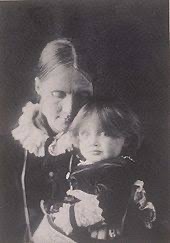
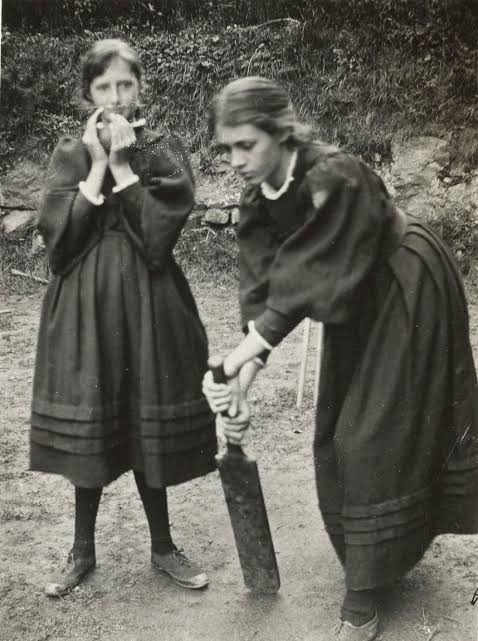
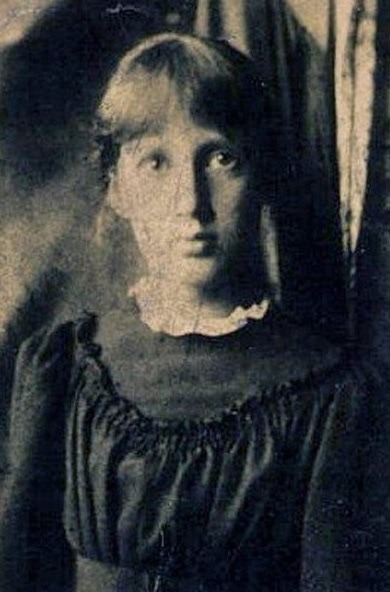

Virginia Woolf .1
#virginia woolf#dark academia#aesthetic#poetryblr#books & libraries#writing#chaotic academia#donna tarrt#poets#a room of one's own#orlando#to the lighthouse#waves#leonard woolf#bloomsbury#womenempowerment#writerscreed#writers#moodboard#light academia#cottagecore#vintage#b&w#childhood#youth#sylvia plath#james joyce#e m forster#writermoodboard
85 notes
·
View notes
Text
Conflict and Genre; Hurting Our Characters in Ways That Matter
If you've even only skimmed my blog, you may have noticed that I preach the importance of character and conflict above all other elements of narrative. The qualities of these dictate the qualities of the story, and by and large, every other narrative element will in part develop from these. I've written a bit about what makes strong characters here and on random other posts, but now it's time to talk conflict: what it is and how we write it.
You'll read everywhere that there are two types of conflict: internal and external. This is true but misaligned. That's kind of like saying the two types of planets are Earth and all the other planets. In reality, most conflicts are a mix of both with varying ratios of one to the other, and "internal" does a lot of heavy lifting in this dichotomy. Is it emotional? Mental? Religious? Interpersonal? A lot of stuff goes on in the human brain!
I've used conflict a bit already without defining it, so let's do so. Conflict is anything in a narrative that negatively affects a character and that character's reaction. It's a broad concept! A duel with a dragon and a tough breakup are equally valid conflicts. You might hear people advise to "hurt your MC." This is true albeit quirky and cliche. Hurt your characters, yes, but the other half of conflict, your character's reaction, is necessary to crafting a strong story. If the duel the dragon, win, and return home victorious, case closed, that's not a very interesting story; if your character goes through the breakup with healthy coping mechanisms and emotional maturity, who cares? What gives? Unless it's the end of the story, the reader doesn't want the conflict to resolve! (Or, they don't want every conflict to resolve. Some can, but always keep one fire lit.)
Your goal as a writer should be to lead your character's decisions deeper into their conflicts. Of course, this shouldn't be obvious--if characters make bad, stupid decisions, the reader will catch on. But you can use your character's flaws and vulnerabilities to make them make poor decisions or otherwise get them in binds without the reader noticing.
One example from my own work: In one of my novels, The Ghosts of Glass Lake, one character focuses on her acting career so she won't have to focus on her mother's suicide. The suicide affected the character negatively, and the focus on acting was her reaction. Obviously, this focus wasn't the healthy thing to do, which gives me as a writer room to play with and grow this conflict. While she's rehearsing, she sees her mother's ghost from time to time. When she does try to resolve this trauma, she goes about it wrong by attempting to speak with her mother via spirit box instead of, y'know, going to therapy. Other characters try to help her cope by dubiously legitimate methods. By the end of the novel, she hasn't reconciled her acting career with the effects of her mother's death, and this tension hurts the people around her.
One example from classic literature: In Virginia Woolf's To the Lighthouse, each character witnesses and thinks upon how other characters treat them and others. This novel has next to no external conflict. One character, Lily Briscoe, loves to paint and notices how the men around her talk about how women can't paint, and a second character mansplains some painting lingo to her. Most of her time in the novel is spent in these interactions or thinking about them and the greater societal shifts that caused them, and by the end of the novel, she accepts herself as a painter and completes the piece she'd been working on.
My and Woolf's examples have some commonalities and some differences. Woolf's is almost entirely internal where mine is almost entirely internal until late in the novel when it grows an external bent. In both cases, conflict is both something that negatively affects a character and that character's reaction to it. This reaction causes the conflict to deepen, which causes another reaction, and a cycle starts that will only resolve (if you want it to resolve) at the end of the narrative.
The type of conflict you write is a question of style, but certain genres historically lend themselves towards one or the other. You'll often hear "genre fiction" and "literary fiction" tossed around in literary discourse. These are two umbrella categories that if you ask me don't really exist anymore, but that's another topic for another time. So disclaimer, read below with a grain of salt, but not too big a grain, as there is truth here.
Genre fiction (fantasy, sci-fi, romance, mystery, thriller) trends towards external conflict: will they kill the dragon and save the princess? Will they win the space war? Find the culprit? Escape the killer? Literary fiction ("the classics," realistic fiction) trends towards internal conflict: how do we come of age? Recognize death? Understand love?
The dichotomy of genre/literary was created during a time when those labels weren't so liquid (here's a great article on the topic), but nowadays, great books blur these lines more than they ever had. Circe is a book with the popular conventions of Percy Jackson but is also a meditation on gender and family obligations. Station Eleven is a post-apocalyptic dystopia about how we find meaning in our everyday lives. American Gods has the trappings of any old adventure story but also questions past and present systems of belief.
And was this genre/literary conflict dichotomy ever real? I would argue no and that the strongest genre fiction also incorporates internal conflict. The Lord of the Rings is a story about Sauron and the Nazgul just as it is about the nature of power and responsibility, advancing technology, and the environment; The Left Hand of Darkness is an adventure across an ice planet but only through the lenses of gender and religion; Dune is about drugs and worms but also religious conflict, imperialism, indigenous culture, and much much more; Earthsea is an adventure through magical archipelagos and also a meditation on grief, gender norms, and reconciliation. You can say similar things as these to any great piece of genre fiction, but I don't personally think this works in reverse. Not every story needs external conflict, as Virginia Woolf shows, though even the most literary of stories will use some, even if only on accident. This is because the best stories always say something deeper about their characters than simply "they can kill the dragon"; the best stories get at what it means to kill a dragon.
So in anything you write, try adding this internal axis! If you're not used to it, try this exercise. Ask yourself what the external conflict is. Then ask yourself how your character feels about it. When you have even 5% of an answer, start writing it! Then when those feelings get that character into more or deeper trouble, ask how they feel about that, then write again. Conflict is what happens to your character as much as what your character's reaction says about them.
Asks are always open if you have any questions!
#writeblr#writing#fanfic#writing resources#writing advice#writing tips#bookblr#booklr#creative writing#writers on tumblr#writing help#writer tips
59 notes
·
View notes
Photo

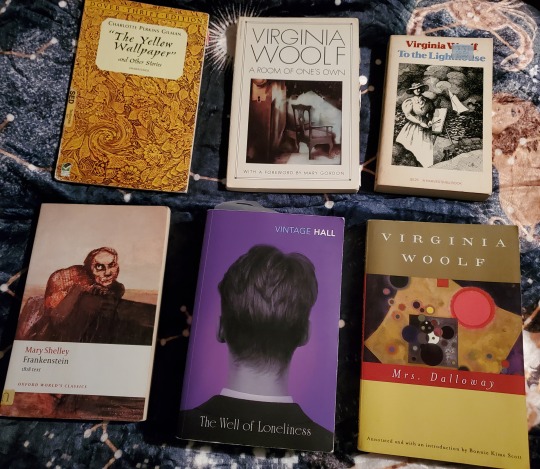


Looking for a good read about or by sapphic women or gay/bi men?
Look no further! I gave all these books 4 or 5 stars when I read them.
Lesbian and bisexual women (subject and author):
Two or three things I know for sure by Dorothy Allison (lesbian memoir)
My Lesbian Experience with Loneliness by Kabi Nagata (graphic novel, lesbian memoir)
The Sealed Letter by Emma Donahue (historic fiction, bisexual woman and lesbian wlw relationship)
Juliet Takes a Breath by Gabi Rivera (ya contemporary, lesbian mc)
Fried Green Tomatoes at The Whistlestop Cafe by Fannie Flagg (historic fiction, butch/femme wlw)
Annie on my Mind by Nancy Garden (ya lesbian classic)
The Well of Loneliness by Radclyffe Hall (historic fiction, lesbian classic)
The Seven Husbands of Evelyn Hugo by Taylor Jenkins Reid (historic fiction, bisexual woman and lesbian wlw relationship)
Marbles: Mania, Depression, Michelangelo and Me by Ellen Forney (graphic novel, memoir- even though it’s mainly about bipolar disorder mostly she is bisexual and it’s mentioned in the novel)
Lesbian or Bisexual Woman author (not necessarily an LGBT subject):
Mrs. Dalloway, To the Lighthouse and A Room of One’s Own all by Virginia Woolf (bisexual author)
Frankenstein by Mary Shelley (bisexual author)
The Little Stranger by Sarah Waters (lesbian author)
The Yellow Wallpaper (and other stories) by Charlotte Perkins Gilman (bisexual author)
The Asylum for Wayward Victorian Girls by Emilie Autumn (bisexual author)
Passing by Nella Larsen (bisexual author)
Transgender Topics:
Female Husbands: A Trans History by Jen Manion (LGBT history- only concerns relationships between historic AFAB couples and AFAB people who lived as men for many reasons- wider career opportunities and being able to marry a woman were the two most common reasons cited across all stories chronicled)
Gay Men and Bisexual Men (subject and/or author):
The Song of Achilles by Madeline Miller (historic fiction, Greek Myths)
Notes of a Native Son by James Baldwin (gay author, essays on race in America)
Boy meets Boy by David Leviathan (ya contemporary mlm romance)
If We were Villains by M. L. Rio (ya, dark academia, mystery)
The Gentleman’s Guide to Vice and Virtue by Mackenzi Lee (historic fiction, bisexual mlm, ya) The two sequels also have more lgbt characters.
#these are my owned lgbt books#that I've read!#my owned tbr has more lgbt lit#and I've read a bunch of lgbt books from the library system or that I borrowed from my school's pride collective library long ago#some of the best ones I ever read are not here#but that will be another post#most of these are 4 or 5 stars#but some of these are heavier than others#books#lgbt lit#annie on my mind#nancy garden#juliet takes a breath#gabi rivera#my lesbian experience with loneliness#kabi nagata#emma donoghue#charlotte perkins gilman#virginia woolf#james baldwin#david levithan#fannie flagg#sarah waters#emilie autumn#radclyffe hall#mackenzi lee#m. l. rio#madeline miller#bookblr#I'm currently rereading the well of loneliness for a paper I'm writing in my grad class
173 notes
·
View notes
Text
♡ Books to Read ♡
girl, interrupted - susanna kaysen
the beguiled - thomas cullinan
my year of rest and relaxation - ottessa moshfegh
girl in pieces - kathleen glasgow
women who run with wolves - clarissa pinkola estés
pride and prejudice - jane austen
the bell jar - sylvia plath
the secret history - donna tartt
black swans - eve babitz
severance - ling ma
beloved trilogy - toni morrison
bad behavior - mary gaitskill
the year of magical thinking - joan didion
there there - tommy orange
valley of the dolls - jacqueline susann
american psycho - bret easton ellis
requiem for a dream - hubert selby jr.
ariel - sylvia plath
lolita - vladimir nabokov
anna karenina - leo tolstoy
rebecca - daphne du maurier
the virgin suicides - jeffrey eugenides
gone with the wind - margaret mitchell
the interpretation of dreams - sigmund freud
the stranger - albert camus
madness and civilization - michel foucault
the woman destroyed - simone de beauvoir
just kids - patti smith
to the lighthouse - virginia woolf
play it as it lays - joan didion
gone girl - gillian flynn
normal people - sally rooney
prozac nation - elizabeth wurtzel
how to murder your life - cat marnell
the catcher in the rye - j.d. salinger
love is a dog from hell - charles bukowski
jane eyre - charlotte brontë
her body and other parties - carmen maria machado
eileen - ottessa moshfegh
bunny - mona awad
little women - louisa may alcott
the perks of being a wallflower - stephen chbosky
homesick for another world - ottessa moshfegh
frankenstein - mary shelley
the picture of dorian gray - oscar wilde
diary of an oxygen thief - anonymous
boy parts - eliza clark
the seven husbands of evelyn hugo - taylor jenkins reid
a room of one's own - virginia wolf
mrs. dalloway - virginia wolf
wuthering heights - emily brontë
slouching towards bethlehem - joan didion
the white album - joan didion
trick mirror: reflections on self-delusion - jia tolentino
the idiot - elif batuman
1984 - george orwell
sense and sensibility - jane austen
the handmaid's tale - margaret atwood
the great gatsby - f. scott fitzgerald
city of girls - elizabeth gilbert
animal - lisa taddeo
a certain hunger - chelsea g. summers
in the dream house - carmen maria machado
the new me - halle butler
death in her hands - ottessa moshfegh
norwegian wood - haruki murakami
the feminine mystique - betty friedan
#ottessa moshfegh#lisa taddeo#female manipulator#lana del rey#coquette#girl interrupted#homesick for another world#my year of rest and relaxation#lily rose depp#sylvia plath#the bell jar#lizzy grant#haruki murakami#carmen maria machado#f scott fitzgerald#brontë#the catcher in the rye#the great gatsby#book#book rec list#book recommendations#femcel#manic pixie dream girl
625 notes
·
View notes
Note
Thank you for responding so thoroughly to my little music question last night.
I too, live almost entirely for the lyrics of a song. Melody has to vibe but the meaning of the song is within the poetry of the lyrics.
I'm very much a bookish sort, and I have the impression that you are too. I'm trying to psych myself up to read "Song of Achilles". Do you have any books that you have enjoyed - from now or past? I understand that Hogwarts curriculum already requires a lot of reading, but it would still be interesting to hear your opinion.
It was my pleasure, darling, and your astute impression of me is correct. I cannot imagine what gave me away. *cheeky smile*
I am a lover of music and the written word in equal measure. Sadly, life such as it is, it has been a shamefully long time since I have read much for pleasure. Seems the number of books I wish to read and the time in which I have to read them are inversely proportional.
"Song of Achilles" is on my list as well. Perhaps we shall finally tackle it together? I've enjoyed many books from many different genres -- fiction and nonfiction alike. I enjoy anything that will engage my mind and emotions, be it fanciful, factual, or thought-provoking.
Not sure if there is a specific genre you were curious about, but here's a short list of long-time favourites, in no particular order:
The Picture of Dorian Grey - Oscar Wilde
Number the Stars by Lois Lowry
The Odyssey - Homer
The Mists of Avalon by Marion Zimmer Bradley
Jane Eyre by Charlotte Brönte
The Book Thief by Markus Zusak
Invisible Man by Ralph Ellison
Crime and Punishment by Dostoyevsky
Oedipus Cycle - Sophocles
Dangerous Liaisons by Pierre Choderlos de Laclos
Frankenstein by Mary Shelley
Dickens (A Christmas Carol, Great Expectations, Oliver Twist, A Tale of Two Cities)
Shakespeare (anything)
Austen (anything)
Steinbeck's short novels
Jazz by Toni Morrison
Virginia Woolf (To the Lighthouse and A Room of One's Own)
Edgar Allen Poe's short stories (including but not limited to: The Cask of Amontillado, The Fall of the House of Usher, The Pit and the Pendulum, The Masque of the Red Death, The Purloined Letter, The Tell-Tale Heart)
16 notes
·
View notes
Text
Whenever she sees them hesitate, Elizabeth Gilbert encourages her interlocutors to ask about her non-motherhood; it's important to her and she likes to discuss it. In contrast, Rebecca Solnit is infuriated at being asked about it so often:
“Part of my own endeavor as a writer has been to find ways to value what is elusive and overlooked, to describe nuances and shades of meaning, to celebrate public life and solitary life, and —in John Berger's phrase—to find ‘another way of telling,’ which is part of why getting clobbered by the same old ways of telling is disheartening.”
She wrote her article on the subject in the wake of a lecture she gave about Virginia Woolf. To her great surprise, the audience discussion rapidly turned to whether Woolf, celebrated author of Mrs. Dalloway and To the Lighthouse, ought to have had children. In 2016, French writer Marie Darrieussecq had the same unpleasant surprise. Invited to talk about her new translation of Woolf's A Room of One's Own on the France Culture radio channel, she was asked the same question. She began by patiently responding that Woolf's sufferings were certainly deep-rooted, but that nothing suggested her lack of children had played a part in them. When the interviewer pressed her on the point, Darrieussec lost her temper: "Really this is beside the point! Excuse me—l'll be polite about it—but really this is too much! Do people ask such questions of a male writer without children? I couldn't care less! For me, this is really to reduce Woolf to the sum of her female body, and this is not at all what she's doing in this essay." . . . These clashes are further confirmation of Pam Grossman's view in the introduction to her celebration of "literary witches," among whom Woolf takes her due place, that "women who create things other than children are still considered dangerous by many." And best beware: even being Virginia Woolf cannot exonerate you for not being a mother. Any readers who are considering not reproducing, or who may have neglected to get on with it, be warned: it's no good locking yourself away and writing masterpieces in a sad attempt at deflecting attention from this grave oversight, which has of course made you very unhappy, even though you don't know it. If you must write masterpieces, do it for other reasons—for the pleasure; otherwise, rather devote the leisure moments of your scandalous existence to reading novels in peace under a tree, or to whatever else you'd like to do.
-Mona Chollet, In Defense of Witches: The Legacy of the Witch Hunts and Why Women are Still on Trial
#mona chollet#biological determinism#motherhood#women writers#cultural expectations#sex roles#non-motherhood
9 notes
·
View notes
Text
top 10 books i read in 2022 (in the order i read them)
the master and margarita by mikhail bulgakov: in the 1930s, the devil comes to moscow; chaos follows. almost 2000 years earlier, pontius pilate sentences the mild preacher jeshua to death. also: kind witches, fireproof manuscripts, the greatest love story ever told;
here by richard mcguire: the corner of a living room from 3,000,500,000 BCE to 22,175 CE, the illusion of time, the joys and sorrows of life, the magic of comic books;
lilith's brood (dawn, adulthood rites, imago) by octavia e. butler: humanity is saved from a nuclear apocalypse by a species of hideous aliens who offer an impossible deal to ensure the continued existence of life on earth. in perfect bulter fashion, tons of discussions about hierarchical structures, gender, language barriers, consent, and the vital need to embrace transhumanism;
the faggots & their friends between revolutions by larry mitchell & ned asta: somewhere in between a fairy tale and a utopian political manifesto, a sacred text from days long gone -- the story of a declining empire ruled by the fascist patriarchy, where gay men, lesbians, feminists, and drag queens live communally, produce art, have sex, and await the next revolution;
earthlings by sayaka murata: three young people become aliens to survive the horrors of modern life. provocative, utterly chaotic, equal parts hilarious and sad;
to the lighthouse by virginia woolf: the epic portrait of a family and of an artist;
nona the ninth by tamsyn muir: god is a man, the divine is most definitely feminine, eating someone is the ultimate way to say 'i love you' -- of bad puns, mismatched families, and the horror of your exes becoming besties;
dolore minimo by giovanna cristina vivinetto: the poetic dialogue between a self-born daughter and her mother-self;
the city and the pillar by gore vidal: a gay man in 1930s-40s america grapples with society's (and his own) prejudices and chases an idealized version of his high school best friend and one-time lover down a path of self-hatred and destruction;
loaded by christos tsiolkas: 24 hours in the life of an angst-ridden gay greek-australian boy as he travels through melbourne in search of drugs, an escape from responsibilities, and something resembling love.
#there's a alternate version of this were i don't limit myself to one book per author and just list off octavia butler's bibliography#but on the other hand there are sooooooo many honorable mentions#daytripper maus the unbearable lightness of being the white book home fire never let me go#the bluest eyes the satanic verses the metamorphosis the other stuff i've read by woolf murata and tsiolkias#soooo much good stuff#books
64 notes
·
View notes
Note
Any thoughts abt a virginia woolf reading order? Ive never read any of her stuff but ive been wanting to ever since my professor for fiction writing told me my stuff reminded her of woolf
Sure! In terms of her essays, I don’t think reading order really matters, but if you haven’t read Modern Fiction yet, it’s a must. The rest I leave up to you; I’ve read a bunch, and even when I don’t agree with her I think they provide context to who she is as a person, but none were (personally!) particularly life changing.
As for fiction! I think chronologically works well. Her first book was The Voyage Out, and I really recommend starting there (If you want something even earlier, her first ever published work was a short story called the mark on the wall that’s a lot of fun). You see the seeds of what will later develop into her signature style, and in all honesty I also just really like the book! The Dalloways (yes, those dalloways) are in it as well so it provides an extra layer to reading Dalloway later. The ending destroys me to this day 🫡
After voyage, I’d recommend you read Jacob’s Room, which is considered her first work of high modernism. After that, Mrs. Dalloway and To The Lighthouse, which are her most famous novels and many people’s favorites. And they’re great! They’re fantastic! Love and adore them!
If you want to, then would be the time to read Orlando and Flush, which are her experiments with the pseudo biography genre. Full disclosure, I actually am not a fan of Orlando—it’s considered a landmark of feminist literature, but I simply don’t enjoy Woolf when she’s primarily focused on being irreverent and satirical, and there’s just a lot of blatant racism in Orlando (one can argue how much is commentary vs Woolf’s own bias or the effectiveness of that commentary) that detracts from the experience of reading it. Idk, just really not my thing, lacks the heart found in a lot of her other work. I haven’t read flush, so no commentary there!
Her last two books are The Waves (my favorite, the one I just spent my entire semester immersed in an writing about) and Between The Acts, which both draw heavily from the stageplay format, are by far her most experimental works, and Between the Acts (which I just started) in particular really reads more like a piece of postmodern literature. Oh! You don’t have to, but her mémoires Moments of Being are great to read before The Waves because she pulls sooo many of those experiences into the novel.
Her diaries and letters are also definitely worth a read, and this isn’t even close to everything she wrote (so many essays and so many reviews). Woolf is an interesting author in that her eras of writing are so distinct, so a chronological reading progression just makes sense imo. I know I threw a lot at you, but truly, take your time and just become immersed in Woolf.
7 notes
·
View notes
Text
classic lit is the only genre of book I buy every time because I just like to annotate and keep note thus I decided to make a read vs to be read of my classics as right now I do have a lot piled up I've been meaning to get to ALSO! I just like talking about classic lit
so please let me know which I should prioritise
physical tbr classics
zami: a new spelling of my name by audre lorde
a room with a view by em forster
the professor by charlotte bronte
a passage to india by em forster
mrs dalloway by virginia woolf
the last tycoon by f.scott fitzgerald
jamaica inn by daphne du maurier
if beale street could talk by james baldwin
howards end by em forster
dr jekyll and mr hyde by robert louis stevenson
antony and cleopatra by william shakespheare
a clockwork orange by anthony burgess
read classics below cut for my tracking
pre 1500s:
the iliad by homer
oedipus the king
1500-1800
the merchant of venice, hamlet, much ado about nothing, king lear pericles, the tempest, othello, measure for measure by william shakespheare
1800-1900
a tale of two cities, hard times, great expectations by charles dickens
heart of darkness by joseph conrad
jane eyre by charlotte bronte
wuthering heights by emily bronte
the tenant of wildfell hall by anne bronte
sherlock holmes by arthur conan doyle
the mill on the floss by george eliot
cousin phyllis by elizabeth gaskell
the moonstone by wilkie collins
little women by louisa may alcott
dracula by bram stoker
maurice, where angels fear to tread by em forster
sense and sensibility, persuasion, emma, pride and prejudice, northanger abbey by jane austen
the turn of the screw by henry james
frankenstein by mary shelley
treasure island by robert louis stevenson
the picture of dorian gray by oscar wilde
black beauty by anna sewell
peter pan by jm barrie
1900-1970
on the road by jack kerouac
dubliners, ulysses by james joyce
the great gatsby, tender is the night by f. scott fitzgerald
rebecca, the house on the strand by daphne du maurier
notes of a native son, giovanni's room by james baldwin
childhood by tove ditlevson
letters to a young poet by rainer maria rilke
voss by patrick white
my brilliant career by miles franklin
nightwood by djuna barnes
brideshead revisted by evelyn waugh
their eyes were watching god by zora neale hurston
one hundred years of solitide by gabriel garcia maquez
wide sargasso sea, good morning midnight by jean rhys
passing by nella larson
the waste land, the lovesong of j.alred prufrock by t.s eliot
to the lighthouse, a room of ones own by virginina woolf
to kill a mockingbird by harper lee
sula by toni morrison
endgame by samuel beckett
things fall apart by chinua achebe
lord of the flies by willian golding
death of a salesman by arthur miller
a streetcar named desire by tenneesee williams
animal farm by george orwell
3 notes
·
View notes
Photo

🇧🇷No dia 28 de março de 1941 morria em Lewes, na Inglaterra, a escritora Virginia Woolf. Depressiva, ela cometeu suicídio afogando-se em um rio com um casaco cheio de pedras nos bolsos. Seu corpo só foi encontrado no dia 18 de abril. Nascida no dia 25 de janeiro de 1882, em Londres, a escritora fazia parte do Grupo de Bloomsbury, círculo de intelectuais que, após a Primeira Guerra Mundial, se posicionou contra as tradições da Era Vitoriana. Virginia também ficou conhecida pela sua participação no movimento modernista. Entre suas obras mais famosas estão “Mrs Dalloway” (1925), “Passeio ao Farol” (1927), “Orlando” (1928) e o livro-ensaio “Um Quarto Só Para Si” (1929). Sua última obra foi “Entre os atos”, publicada em 1941, após sua morte. --------------------- 🇺🇸On March 28, 1941, writer Virginia Woolf died in Lewes, England. Suffering from depression, she committed suicide by drowning herself in a river with a coat filled with stones in her pockets. Her body was only found on April 18. Born on January 25, 1882, in London, the writer was part of the Bloomsbury Group, a circle of intellectuals who, after World War I, opposed the traditions of the Victorian Era. Virginia was also known for her involvement in the modernist #mong her most famous works are "Mrs. Dalloway" (1925), "To the Lighthouse" (1927), "Orlando" (1928), and the essay book "A Room of One's Own" (1929). Her last work was "Between the Acts", published in 1941 after her death. Foto: Internet info: history.uol.com.br Colorização: @coresdopassado1 • • • • • #virginawoolfquote #virginiawoolfsociety #virginawoolf #virginiawoolffrases #virginiawoolforlando #vriginiawoolf #colorization #colorização #coloring #colorizationphotos #colorización #literature #netflixbrasil #redeglobotv #restauracaodefotos #colorizaçãodigital #restauraçãofotográfica #brasil #brazil #brasil🇧🇷 #portugal🇵🇹 #deutschland🇩🇪 #germany🇩🇪 #argentina🇦🇷 #italy🇮🇹 #france🇫🇷 (em Manaus - Amazons - Brazil) https://www.instagram.com/p/CqVa_mHrtmB/?igshid=NGJjMDIxMWI=
#mong#virginawoolfquote#virginiawoolfsociety#virginawoolf#virginiawoolffrases#virginiawoolforlando#vriginiawoolf#colorization#colorização#coloring#colorizationphotos#colorización#literature#netflixbrasil#redeglobotv#restauracaodefotos#colorizaçãodigital#restauraçãofotográfica#brasil#brazil#brasil🇧🇷#portugal🇵🇹#deutschland🇩🇪#germany🇩🇪#argentina🇦🇷#italy🇮🇹#france🇫🇷
3 notes
·
View notes
Photo
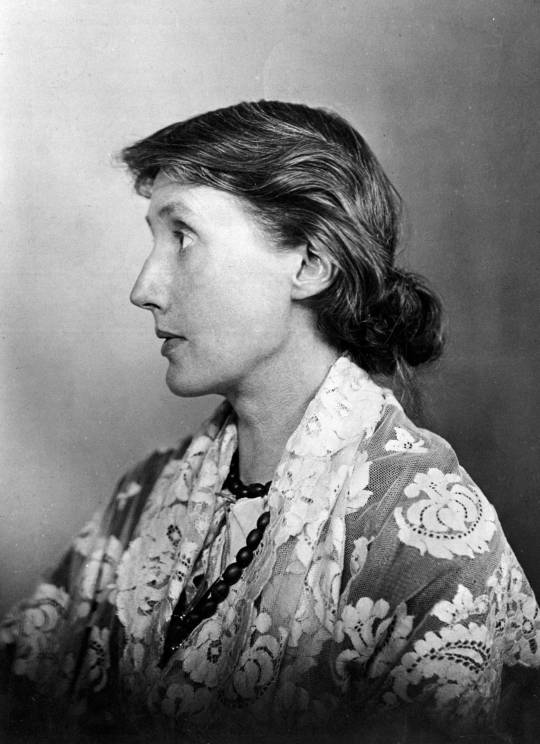
Virginia Woolf (1882–1941)
A prominent modernist writer best known for her novels, essays, diaries, and letters, and for her use of the stream-of-consciousness technique to weave the memories and interior thoughts of her characters into the narrative. As a result, her work is characterized by vibrant portraits of its main characters, and in particular for its nuanced and deep portrayals of the inner lives of women. Woolf wrote about the rapidly shifting technologies and gender roles of the time in which she lived. She also emphasized moving beyond framing experience in terms of binary oppositions, advocating instead for a “perpetual marriage of granite and rainbow” (“The New Biography”) and bringing a more imaginative approach to fiction.
In particular, Virginia Woolf was interested in the idea of biography, and of exploring “an ordinary mind on an ordinary day” (from “Modern Fiction”) rather than people deemed “great” by society. In her essay “The Art of Biography”, Woolf wrote:
“The question now inevitably asks itself, whether the lives of great men only should be recorded. Is not anyone who has lived a life, and left a record of that life, worthy of biography – the failures as well as the successes, the humble as well as the illustrious.”
She ran Hogarth Press, a publishing house, with her husband Leonard Woolf, publishing writers like T S Eliot, Sigmund Freud, Katherine Mansfield, E M Forster, and of course the Woolfs themselves. The couple’s house was a hub for lots of intellectual activity, namely by the Bloomsbury Group, a group of artists, writers, and intellectuals who were massively influential in the early 20th century.
In 1922, after the publication of her novel Jacob’s Room, the first of her more nontraditional works, she wrote in her diary: “There’s no doubt in my mind that I have found out how to begin (at forty) to say something in my own voice, and that interests me so that I feel I can go ahead without praise.” Later that year, she notes further, “At forty I am beginning to learn the mechanism of my own brain – how to get the greatest amount of pleasure and work out of it.” Virginia’s most well-known novels are Mrs. Dalloway (1925) and To The Lighthouse (1927), and one of her best-known essays is “A Room of One’s Own” (1929), a key work of feminist literary criticism that imagines a sister for William Shakespeare and examines the limitations placed on women who make art in comparison to men. She also originated the concept of the “Angel of the House” in her essay “Professions for Women”, a confined figure who must stay at home, perpetuate womanly virtues, and sacrifice for the men of the household; it is thought that this relates to her difficult upbringing, with a father who was both a famous writer and also abusive to Virginia and her siblings.
In terms of Virginia’s personal life, she struggled with depression throughout her life, experiencing multiple nervous breakdowns and periods of deep grief related to the death of her parents and brother. Virginia experienced romantic attachments to several women in her late teens and early twenties, including Madge Vaughan and Violet Dickinson (about whom Virginia wrote in her diary in 1922: “is love the word for these strange deep ancient affections, which began in youth and have got mixed up with so many important things?”). She met and began an affair with Vita Sackville-West around 1924, which eventually culminated in Orlando, a Biography (1928), frequently referred to as “the longest love letter in the English language.”
Ultimately, as World War II’s threat to life in England grew, Woolf found herself unable to write any longer and took her own life in March, 1941. She left her husband, Leonard, this message: “I owe all my happiness in life to you. You have been so perfectly good.”
4 notes
·
View notes
Note
hey justine! i see you reblogging beautiful quotes all the time and i was wondering if you could recommend me your favorite authors or books/poetry/anything?
this is so sweet <3
the list would be very VERY long if i was given an opportunity to put here every single writer and poet i love but for now i'll give you names of those who i've been reblogging (and obsessing over or came back to) a lot lately.
─ mary oliver (upstream: selected essays, devotions: the selected poems, a thousand mornings: poems)
─ virginia woolf (a room of one's own, to the lighthouse, the waves)
─ franz kafka (basically all of his short stories, e.g. the trial, the metamorphosis, his letters and diaries)
─ anne carson (as a translator the thing that mostly interests me in carson is her transaltion and adaptation of the oresteia - an oresteia but when it comes to poetry i'll point to plainwater: essays and poetry. i hope to read more from her and you can also find titles of her works on goodreads!)
─ anne sexton (selected or collected poems and i read that her letters are worth reading!)
─ clarice lispector (a breath of life and other, e. g. the hour of the star, the passion according to g. h., near to the wild heart, famaily ties)
─ susan sontag (journals and essays)
─ anaïs nin (her diaries)
─ albert camus (if you're interested in pondering upon human condition and existentialism, then everything this author has to offer! e. g. the stranger, the fall, the plague, the myth of sisyphus)
─ louise glück (collections of poems, e. g. poems 1962-2012, the triumph of achilles, averno)
─ george seferis (selected or collected poems)
─ rainer maria rilke (letters to a young poet, collected or selected poems, his letters)
#answered#anonymous#of course it wouldn't be me if i didn't recommend classic authors:#mary shelley; oscar wilde; william shakespeare; jane austen; sisters bronte; dostoevsky.#it's not all of them but i needed to write some of them down.#thank you for this message! talking about literature always makes my day <3
1 note
·
View note